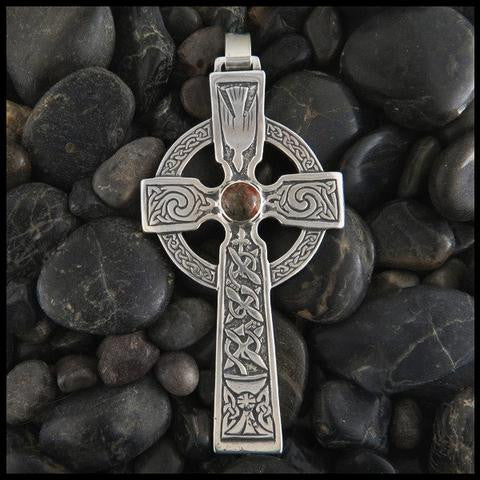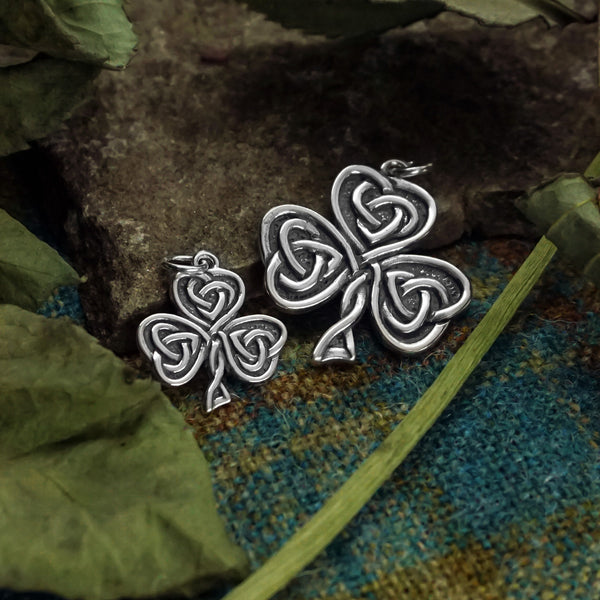
Colum Cille - St. Columba

Before giving birth, legend states, Eithne had a dream that she was given a beautiful cloak of many colors. The cloak stretched out from the shore of her native Ireland north to Scotland. She dreamed that the magnificent cloak was taken from her by a young man and this made her very sad. The man returned in her dream and told her not to grieve because the dream meant that she would give birth to a son who would be renowned for his teaching throughout Scotland and Ireland and she should be joyful.
On Thursday 7 December 521 A. D. in County Donegal the boy was born and named Crimthain meaning ‘fox’ or ‘cunning wolf’. As a young boy he was so fond of prayer that he came to be called Colum Cille (Kol-lum-kill), meaning ‘Dove of the Church’ or Columba in Latin.
His birth was eighty years after the death of St. Patrick. Colum Cille’s family was the Royal House of Uí Néill. The Gaelic Irish had heard the Gospels for several generations by this time. Rome had abandoned Britain for more than a century and the Church in Ireland was evolving in relative isolation as Pagan tribes occupied much of the remainder of the Continent with the decline of the Roman Empire. The missions from Celtic Church were about to shine forth the light of the Gospels to Britain and spread the word of God’s love to Northern Europe.
From childhood he was destined for a religious vocation although it is believed that he was by birth a possible successor to the high King of Ireland. Columba entered the monastery of St. Finian at Movilla where he studied theology and the arts of copying and illuminating sacred texts and became a deacon of the church. His love of words lead him to also to study with the bard Gemman from whom he learned the traditional poetry and ancient traditions of the Gaels. Several hymns and poems composed by Columba survive to this day.
Columba’s love of books and his talent with words are still among his most famous attributes. In Ireland and Scotland today it is a popular folk belief that the Book of Kells was penned by the Saints own hand. The oldest surviving Irish manuscript, a manuscript of Psalms known as the ‘Cathach’ is plausibly his work. The Book of Kells, a fantastically illuminated copy of the four Gospels but was actually created around 200 years after Columba’s death.
A chain of events began when Columba was aged forty that led him to leave Ireland. By this time Columba was a priest and had founded numerous churches and monasteries. He traveled widely and was already an important leader of the Church. These were exciting, optimistic times for a young growing Church. They were however violent times as well and as we shall see. The clergy was no less immune to getting mixed up in political and clan rivalries then than in times since.
The trouble began when Columba secretly made a copy of a book of Psalms, Mosaic Law and the Four Gospels known as St. Martin’s Gospel. The book was property of his friend Finian of Movilla. When Finian discovered the copy he angrily demanded the copy be given to him as his rightful property. Columba insisted that the copy did not in any way diminish the original and demanded that High King Diarmid judge legal ownership. The King handed down what may be the first recorded copyright judgment with the words: “To every cow her calf, to every book it’s copy.” and thus upheld Finian’s claim against Columba.
There are many legends in Ireland about St. Columba’s anger and short temper. Many Irish to this day when cutting peat for fuel will leave a step in the turf bank because of the legend that after falling while crossing one of these banks Columba angrily cursed any peat cutter who would not leave a step so that others could easily cross. Columba’s anger went beyond cursing when ownership of the book was judged against him.
In a very un-saintly way Columba rallied his family and friends against the King. Historians are skeptical that the book judgment alone is actually what led to the bloodshed. The factions already had strained relations, but popular tradition puts Columba’s rejection of the King’s ruling as the cause of the Battle of Cuildrevne. The King was defeated but at the cost of thousands slaughtered.
The King appealed to the Church for Columba’s excommunication. A synod was held and Columba’s friend Brendan of Birr argued for Columba and his confessor and soul friend St. Molaisse advised as penance he accept lifelong exile from Ireland. A remorseful Columba welcomed this punishment and set sail for Scotland to win as many souls for Christ as had been lost in the battle.
With twelve companions Columba set sail in 563 A. D. to the north and after stopping at Oransay and Islay, where the shores of Ireland were still visible he landed on the tiny island of Iona at a shore now known as the ‘Port of the Coracle’.
Iona and the surrounding islands of the Hebrides were occupied sparsely by the Picts. Other Irish Gaels prior to Columba and known then as the Scots were establishing settlements in southwest Scotland and created a Kingdom called Dalriada in the area now called Argyll. Columba traveled north to Inverness to visit the Pagan Pictish King Brude. He initially did not convert Brude but he did become friends with him. Brude granted Iona to Columba and his monks and gave him safe passage to preach and conduct his mission. Diplomatically Columba also visited the Irish ruler of Dalriada, Conall mac Comgaill, who also granted Iona to Columba.
To the Dalriad Scots Columba was soon to become their local spiritual authority. When King Conall died in 574 Columba was called upon to ordain Áedán as his successor and is thus the first king in Britain to receive the blessing of the Church as a mandate of a legitimate rule.
It is to the Picts in the North that Columba found fresh converts to the Faith. Like the pre-Christian Irish, the Picts followed the religion of the Druids. Columba preached, baptized and ordained among them in much the same way that Patrick ministered to the Irish a century before. For many years, before he was superseded by St. Andrew, he was the patron saint of Scotland. From his base on Iona his little band of missionaries branched out and founded churches and monasteries that soon reached to England and beyond.
So influential did the Abby at Iona become that soon it was a center for Christian education for Ireland as well. The warrior holy man of the Battle of Cuildrevne preached God’s love in his new land. His skill as a diplomat and his respected
Spiritual authority helped lessen the level of warfare in those violent days. The artistic tradition that is exemplified by the Book of Kells spread to England and Europe. The Book of Kells itself may well have been created on Iona to commemorate the 200th anniversary of St. Columba’s death or it may have been completed at Kells in Ireland when Viking raids forced the evacuation of Iona to Kells around the year 800.
The story of Saint Columba and the Heron tells how the Saint foresaw the visit of a tired and injured "visitor" from Ireland. He sent one of his monks to the western beach to wait for it and an exhausted heron arrived. The monks fed and cared for the bird until it could travel again. Colum Cille himself was an exile from Ireland, so the lonely visitor from his beloved home was of symbolic significance.
Columba lived to the age of 76 years. Tradition records that he knew that he was soon going to die and that he wanted to leave this world at Eastertide. He reconsidered since he did not want to make the feast a time of mourning for his brethren and waited a little longer. On his last day he was carried to the fields were the monks were working and blessed the crops. An old white horse which had carried the brother’s milk for many years approached him and rested his head on Columba’s shoulder and was seen to weep tears. When he returned to his cell the Saint took up his pen and worked at copying Psalm 34 and stopped at the tenth verse, “but those who seek the Lord lack no good thing”, and stated that someone else would have to finish it. He died at the altar of his church at the midnight service. His feast day marks his passage to heaven on the 9th of June 597.
The Celtic Church of Columba’s day was not as divided as the church was in future generations. The Celtic and British Church was independent of Rome due to its isolation and separate development. The year of Columba’s death, 597 was the same year that Augustine was sent by the Pope to bring British Christians under the authority of Rome. Traces of the distinctly Celtic interpretation of the faith that took root in those early days survive in the heritage of the Catholic, the Anglican and the Church of Scotland. The Church of Scotland is of course the progenitor of the Presbyterian Church.
A Christian community has rebuilt the Abby on Iona and it is once more a center of worship, study and pilgrimage.
Before giving birth, legend states, Eithne had a dream that she was given a beautiful cloak of many colors. The cloak stretched out from the shore of her native Ireland north to Scotland. She dreamed that the magnificent cloak was taken from her by a young man and this made her very sad. The man returned in her dream and told her not to grieve because the dream meant that she would give birth to a son who would be renowned for his teaching throughout Scotland and Ireland and she should be joyful.
On Thursday 7 December 521 A. D. in County Donegal the boy was born and named Crimthain meaning ‘fox’ or ‘cunning wolf’. As a young boy he was so fond of prayer that he came to be called Colum Cille (Kol-lum-kill), meaning ‘Dove of the Church’ or Columba in Latin.
His birth was eighty years after the death of St. Patrick. Colum Cille’s family was the Royal House of Uí Néill. The Gaelic Irish had heard the Gospels for several generations by this time. Rome had abandoned Britain for more than a century and the Church in Ireland was evolving in relative isolation as Pagan tribes occupied much of the remainder of the Continent with the decline of the Roman Empire. The missions from Celtic Church were about to shine forth the light of the Gospels to Britain and spread the word of God’s love to Northern Europe.
From childhood he was destined for a religious vocation although it is believed that he was by birth a possible successor to the high King of Ireland. Columba entered the monastery of St. Finian at Movilla where he studied theology and the arts of copying and illuminating sacred texts and became a deacon of the church. His love of words lead him to also to study with the bard Gemman from whom he learned the traditional poetry and ancient traditions of the Gaels. Several hymns and poems composed by Columba survive to this day.
Columba’s love of books and his talent with words are still among his most famous attributes. In Ireland and Scotland today it is a popular folk belief that the Book of Kells was penned by the Saints own hand. The oldest surviving Irish manuscript, a manuscript of Psalms known as the ‘Cathach’ is plausibly his work. The Book of Kells, a fantastically illuminated copy of the four Gospels but was actually created around 200 years after Columba’s death.
A chain of events began when Columba was aged forty that led him to leave Ireland. By this time Columba was a priest and had founded numerous churches and monasteries. He traveled widely and was already an important leader of the Church. These were exciting, optimistic times for a young growing Church. They were however violent times as well and as we shall see. The clergy was no less immune to getting mixed up in political and clan rivalries then than in times since.
The trouble began when Columba secretly made a copy of a book of Psalms, Mosaic Law and the Four Gospels known as St. Martin’s Gospel. The book was property of his friend Finian of Movilla. When Finian discovered the copy he angrily demanded the copy be given to him as his rightful property. Columba insisted that the copy did not in any way diminish the original and demanded that High King Diarmid judge legal ownership. The King handed down what may be the first recorded copyright judgment with the words: “To every cow her calf, to every book it’s copy.” and thus upheld Finian’s claim against Columba.
There are many legends in Ireland about St. Columba’s anger and short temper. Many Irish to this day when cutting peat for fuel will leave a step in the turf bank because of the legend that after falling while crossing one of these banks Columba angrily cursed any peat cutter who would not leave a step so that others could easily cross. Columba’s anger went beyond cursing when ownership of the book was judged against him.
In a very un-saintly way Columba rallied his family and friends against the King. Historians are skeptical that the book judgment alone is actually what led to the bloodshed. The factions already had strained relations, but popular tradition puts Columba’s rejection of the King’s ruling as the cause of the Battle of Cuildrevne. The King was defeated but at the cost of thousands slaughtered.
The King appealed to the Church for Columba’s excommunication. A synod was held and Columba’s friend Brendan of Birr argued for Columba and his confessor and soul friend St. Molaisse advised as penance he accept lifelong exile from Ireland. A remorseful Columba welcomed this punishment and set sail for Scotland to win as many souls for Christ as had been lost in the battle.
With twelve companions Columba set sail in 563 A. D. to the north and after stopping at Oransay and Islay, where the shores of Ireland were still visible he landed on the tiny island of Iona at a shore now known as the ‘Port of the Coracle’.
Iona and the surrounding islands of the Hebrides were occupied sparsely by the Picts. Other Irish Gaels prior to Columba and known then as the Scots were establishing settlements in southwest Scotland and created a Kingdom called Dalriada in the area now called Argyll. Columba traveled north to Inverness to visit the Pagan Pictish King Brude. He initially did not convert Brude but he did become friends with him. Brude granted Iona to Columba and his monks and gave him safe passage to preach and conduct his mission. Diplomatically Columba also visited the Irish ruler of Dalriada, Conall mac Comgaill, who also granted Iona to Columba.
To the Dalriad Scots Columba was soon to become their local spiritual authority. When King Conall died in 574 Columba was called upon to ordain Áedán as his successor and is thus the first king in Britain to receive the blessing of the Church as a mandate of a legitimate rule.
It is to the Picts in the North that Columba found fresh converts to the Faith. Like the pre-Christian Irish, the Picts followed the religion of the Druids. Columba preached, baptized and ordained among them in much the same way that Patrick ministered to the Irish a century before. For many years, before he was superseded by St. Andrew, he was the patron saint of Scotland. From his base on Iona his little band of missionaries branched out and founded churches and monasteries that soon reached to England and beyond.
So influential did the Abby at Iona become that soon it was a center for Christian education for Ireland as well. The warrior holy man of the Battle of Cuildrevne preached God’s love in his new land. His skill as a diplomat and his respected
Spiritual authority helped lessen the level of warfare in those violent days. The artistic tradition that is exemplified by the Book of Kells spread to England and Europe. The Book of Kells itself may well have been created on Iona to commemorate the 200th anniversary of St. Columba’s death or it may have been completed at Kells in Ireland when Viking raids forced the evacuation of Iona to Kells around the year 800.
The story of Saint Columba and the Heron tells how the Saint foresaw the visit of a tired and injured "visitor" from Ireland. He sent one of his monks to the western beach to wait for it and an exhausted heron arrived. The monks fed and cared for the bird until it could travel again. Colum Cille himself was an exile from Ireland, so the lonely visitor from his beloved home was of symbolic significance.
Columba lived to the age of 76 years. Tradition records that he knew that he was soon going to die and that he wanted to leave this world at Eastertide. He reconsidered since he did not want to make the feast a time of mourning for his brethren and waited a little longer. On his last day he was carried to the fields were the monks were working and blessed the crops. An old white horse which had carried the brother’s milk for many years approached him and rested his head on Columba’s shoulder and was seen to weep tears. When he returned to his cell the Saint took up his pen and worked at copying Psalm 34 and stopped at the tenth verse, “but those who seek the Lord lack no good thing”, and stated that someone else would have to finish it. He died at the altar of his church at the midnight service. His feast day marks his passage to heaven on the 9th of June 597.
The Celtic Church of Columba’s day was not as divided as the church was in future generations. The Celtic and British Church was independent of Rome due to its isolation and separate development. The year of Columba’s death, 597 was the same year that Augustine was sent by the Pope to bring British Christians under the authority of Rome. Traces of the distinctly Celtic interpretation of the faith that took root in those early days survive in the heritage of the Catholic, the Anglican and the Church of Scotland. The Church of Scotland is of course the progenitor of the Presbyterian Church.
A Christian community has rebuilt the Abby on Iona and it is once more a center of worship, study and pilgrimage.
Comments will be approved before showing up.


Thousands of photographs were taken. Help find at least one.
Were you a tourist in London, Dublin or Paris in 1975 – 1978? Did you see a street performer playing bagpipes? Did you take his picture? Was it Steve Walker? If you can share that picture with Walker Metalsmiths you could score some sweet Celtic jewelry.
